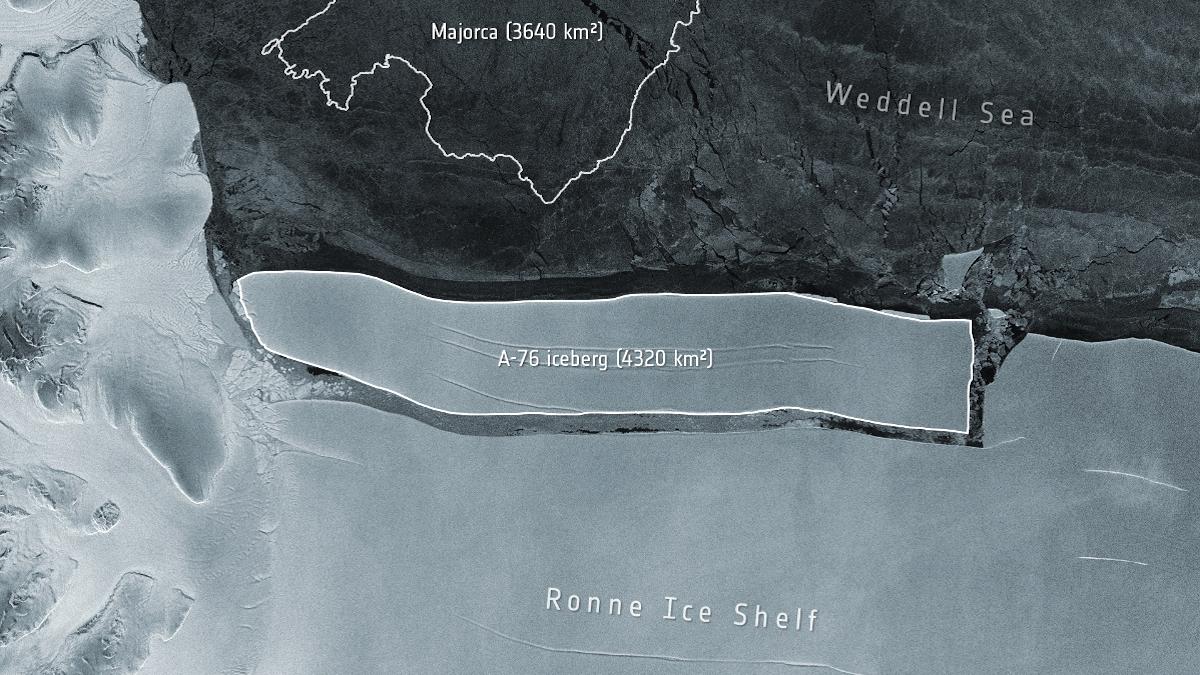

A massive chunk of ice broke off of Antarctica this month, and it is now the largest iceberg in the world.
The iceberg, known as A-76, was first spotted by a British Antarctic Survey researcher May 13. It was then confirmed by the U.S. National Ice Center (USNIC) the next day using images from the Sentinel-1A satellite.
“New giant #iceberg breaking away from the Ronne Ice Shelf,” researcher Keith Makinson announced on Twitter.
New giant #iceberg breaking away from the Ronne Ice Shelf 13-05-2021 roughly 160 km x 25 km satellite image from @polarview @CopernicusEU #Sentinel1 pic.twitter.com/LmacupcuUW
— Keith Makinson (@KeithMakinson1) May 13, 2021
The iceberg first broke off from the western edge of the Ronne Ice Shelf, which is located in Antarctica’s Weddell Sea, according to the European Space Agency (ESA). It is 89 nautical miles long by 14 nautical miles wide, according to USNIC, and has an area of 1,668 square miles, according to Reuters. To put that in perspective, it is larger than both the Spanish island of Mallorca, at 1,405 square miles, and the state of Rhode Island, at 1,034 square miles. It is also almost six times larger than New York City, HuffPost calculated.
The iceberg’s size makes it the largest in the world, according to the ESA. It dwarfs the A-23A iceberg, which is also floating in the Weddell Sea and is around 3,880 square kilometers (approximately 1,498 square miles).
Relive the birth of the #A76 iceberg with this stunning animation!
The animation was created using four @CopernicusEU #Sentinel1 images and shows the giant slab of ice breaking off from the Ronne Ice Shelf on 13 May 2021.
A-76 is currently the biggest iceberg in the world? pic.twitter.com/h97PbYdo0y
— ESA EarthObservation (@ESA_EO) May 20, 2021
While the iceberg is large in size, its calving isn’t necessarily a big deal from a climate perspective. In fact, iceberg calving can be a natural part of an ice shelf’s cycle, as long as the ice shelf gains as much mass through snowfall as it loses to icebergs.
“Even relatively large calving events, where tabular ice chunks the size of Manhattan or bigger calve from the seaward front of the shelf, can be considered normal if the ice sheet is in overall balance,” NASA explained.
The Ronne Ice Shelf is the second largest in Antarctica, according to HuffPost. It and another ice shelf, the Ross Ice Shelf, have “behaved in a stable, quasi-periodic fashion” for the past 100 years or more, University of Colorado at Boulder research glaciologist Ted Scambos told Reuters.
He said he did not think the calving had anything to do with the climate crisis. However, some ice shelves near the Antarctic Peninsula are disintegrating rapidly, which may be because of rising temperatures, Reuters explained.
While A-76’s calving is part of a natural cycle, that doesn’t mean it wasn’t surprising.
“We could watch them for years and they won’t do anything and elsewhere there will be this perfectly solid ice shelf that will suddenly collapse unexpectedly,” Christopher Readinger, the lead analyst for the USNIC’s Antarctic team, told HuffPost.
The iceberg will now eventually melt and break into smaller pieces. It will not contribute to sea level rise, because the Ronne Ice Shelf was already floating on the ocean, Scambos told Reuters.

 233k
233k  41k
41k  Subscribe
Subscribe 